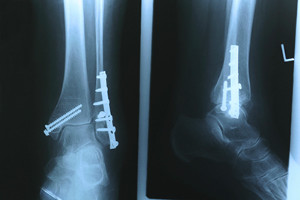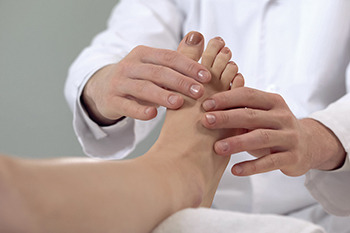Items filtered by date: September 2022
Tips for Beginner Runners

All runners sustain injuries from time to time. If you are a beginning runner, it is important to start slowly and maintain a training level a bit beneath your ability. Over- training is one of the first ways runners get injured. If you become injured while running, resting is the first course of action. So, for example, if you pull a muscle, stop running and walk for a bit to see if the pain diminishes. Rest until you can resume running pain free. Most injuries suffered as beginning runners are minor and heal quickly but if your pain persists, it is suggested you see a podiatrist for a proper diagnosis and treatment, as well as additional tips on running safely.
All runners should take extra precaution when trying to avoid injury. If you have any concerns about your feet, contact one of our podiatrists of Parkwood Podiatry. Our doctors will treat your foot and ankle needs.
How to Prevent Running Injuries
There are a lot of mistakes a runner can make prior to a workout that can induce injury. A lot of athletes tend to overstretch before running, instead of saving those workouts for a post-run routine. Deep lunges and hand-to-toe hamstring pulls should be performed after a workout instead of during a warmup. Another common mistake is jumping into an intense routine before your body is physically prepared for it. You should try to ease your way into long-distance running instead of forcing yourself to rush into it.
More Tips for Preventing Injury
- Incorporate Strength Training into Workouts - This will help improve the body’s overall athleticism
- Improve and Maintain Your Flexibility – Stretching everyday will help improve overall performance
- “Warm Up” Before Running and “Cool Down” Afterward – A warm up of 5-10 minutes helps get rid of lactic acid in the muscles and prevents delayed muscle soreness
- Cross-Training is Crucial
- Wear Proper Running Shoes
- Have a Formal Gait Analysis – Poor biomechanics can easily cause injury
If you have any questions, please feel free to contact our offices located in Brunswick and Hinesville, GA . We offer the newest diagnostic and treatment technologies for all your foot care needs.
Common Foot Injuries Among Athletes

Foot injuries among athletes usually come from overuse. Feet basically dictate the rest of the movements in the lower body. They function to absorb shock and provide a rigid surface to push off from. High stress placed on feet during sports can cause imbalances in muscles that may lead to biomechanical dysfunction of the feet. This in turn can cause pain and interference with an athlete’s mobility. The most common overuse injuries among athletes include turf toe, bunions, and plantar fasciitis. Turf toe happens due to repetitive hyperextension of the big toe. This is seen in athletes who wear shoes that are lightweight and flexible and performing movements that require repeated and forced hyperextension of the big toe. Pain in the big toe is the most common symptom of this condition. Bunions happen to those who over-pronate. Instead of using muscles to support the arch, patients may rely on ligaments and bones to support the foot when walking, and this may cause the arch to collapse. Push off is from the big toe rather than the ball of the foot. The most common symptom is pain at the inside of the big toe. This is worsened by wearing narrow shoes with insufficient room in the toe box. Over time, the big toe moves towards the other toes. Plantar fasciitis happens to athletes who over-pronate and do not have enough strength in their foot muscles. It is associated with running, jumping, and other repetitive movements. It comes from inflammation and micro-tearing of the plantar fascia. Someone with plantar fasciitis has pain with their first steps in the morning, tenderness along the arch and heel of the foot, and tenderness in the plantar fascia. If you are an athlete and experience foot pain, it is wise to consult with a podiatrist who can make a proper diagnosis and provide appropriate treatment options.
Sports related foot and ankle injuries require proper treatment before players can go back to their regular routines. For more information, contact one of our podiatrists of Parkwood Podiatry. Our doctors can provide the care you need to keep you pain-free and on your feet.
Sports Related Foot and Ankle Injuries
Foot and ankle injuries are a common occurrence when it comes to athletes of any sport. While many athletes dismiss the initial aches and pains, the truth is that ignoring potential foot and ankle injuries can lead to serious problems. As athletes continue to place pressure and strain the area further, a mild injury can turn into something as serious as a rupture and may lead to a permanent disability. There are many factors that contribute to sports related foot and ankle injuries, which include failure to warm up properly, not providing support or wearing bad footwear. Common injuries and conditions athletes face, including:
- Plantar Fasciitis
- Plantar Fasciosis
- Achilles Tendinitis
- Achilles Tendon Rupture
- Ankle Sprains
Sports related injuries are commonly treated using the RICE method. This includes rest, applying ice to the injured area, compression and elevating the ankle. More serious sprains and injuries may require surgery, which could include arthroscopic and reconstructive surgery. Rehabilitation and therapy may also be required in order to get any recovering athlete to become fully functional again. Any unusual aches and pains an athlete sustains must be evaluated by a licensed, reputable medical professional.
If you have any questions please feel free to contact our offices located in Brunswick and Hinesville, GA . We offer the newest diagnostic and treatment technologies for all your foot and ankle needs.
Surgery for Ankle Fractures

An individual can break or fracture their ankle by experiencing different kinds of trauma, such as twisting ankle movements or injuries. If you have a fractured ankle, it is possible that the fracture is partial or complete in the affected bone. Additionally, the fracture may have developed where the ligament has been impacted. Sometimes, a medical professional will recommend undergoing a surgical procedure to treat a broken or fractured ankle if they believe that the injury will heal best with surgery. Particularly, if the fracture has spread to the joint in the ankle, a medical professional may recommend surgery. After undergoing a surgical procedure to treat a broken ankle, you may need to wear some sort of cast or splint for an extended period of time. This is largely dependent on the severity of your injury. You may also be instructed to limit the extent to which you put weight on the affected ankle. It is also possible that to continue to be mobile, you may have to use crutches following the surgery. If you have a broken ankle, contact a podiatrist who can assess your situation and discuss your options.
Broken ankles need immediate treatment. If you are seeking treatment, contact one of our podiatrists from Parkwood Podiatry. Our doctors can provide the care you need to keep you pain-free and on your feet.
Broken Ankles
A broken ankle is experienced when a person fractures their tibia or fibula in the lower leg and ankle area. Both of these bones are attached at the bottom of the leg and combine to form what we know to be our ankle.
When a physician is referring to a break of the ankle, he or she is usually referring to a break in the area where the tibia and fibula are joined to create our ankle joint. Ankles are more prone to fractures because the ankle is an area that suffers a lot of pressure and stress. There are some obvious signs when a person experiences a fractured ankle, and the following symptoms may be present.
Symptoms of a Fractured Ankle
- Excessive pain when the area is touched or when any pressure is placed on the ankle
- Swelling around the area
- Bruising of the area
- Area appears to be deformed
If you suspect an ankle fracture, it is recommended to seek treatment as soon as possible. The sooner you have your podiatrist diagnose the fracture, the quicker you’ll be on the way towards recovery.
If you have any questions, please feel free to contact our offices located in Brunswick and Hinesville, GA . We offer the newest diagnostic and treatment technologies for all your foot care needs.
Wounds That Don't Heal Need to Be Checked
Diagnosing a Broken Foot

One should always take a broken foot seriously. When someone breaks or fractures the foot, they may experience a wide range of unpleasant symptoms. For example, the individual might notice a sensation of tenderness, a loss of feeling around the affected area, visible changes to the skin like bruising or swelling, and a cracking sound whenever the foot is moved. A medical professional, such as a podiatrist, can help diagnose your broken foot in different ways. For example, a simple examination of your foot might be performed whereby skin breaks and foot movement are analyzed. Additionally, to diagnose your broken foot, an X-ray, MRI, or CT scan might be performed. Through these procedures, pictures are taken of the affected foot with the aid of contrast liquid. This kind of liquid essentially improves how visible your foot will be in a picture. Lastly, to diagnose your broken foot, a medical professional may perform what is known as a bone scan. No matter how a diagnosis is performed, you should contact a podiatrist if you suspect a broken foot. A podiatrist will help you identify and treat the problem.
A broken foot requires immediate medical attention and treatment. If you need your feet checked, contact one of our podiatrists from Parkwood Podiatry. Our doctors can provide the care you need to keep you pain-free and on your feet.
Broken Foot Causes, Symptoms, and Treatment
A broken foot is caused by one of the bones in the foot typically breaking when bended, crushed, or stretched beyond its natural capabilities. Usually the location of the fracture indicates how the break occurred, whether it was through an object, fall, or any other type of injury.
Common Symptoms of Broken Feet:
- Bruising
- Pain
- Redness
- Swelling
- Blue in color
- Numbness
- Cold
- Misshapen
- Cuts
- Deformities
Those that suspect they have a broken foot shoot seek urgent medical attention where a medical professional could diagnose the severity.
Treatment for broken bones varies depending on the cause, severity and location. Some will require the use of splints, casts or crutches while others could even involve surgery to repair the broken bones. Personal care includes the use of ice and keeping the foot stabilized and elevated.
If you have any questions please feel free to contact our offices located in Brunswick and Hinesville, GA . We offer the newest diagnostic and treatment technologies for all your foot and ankle needs.

